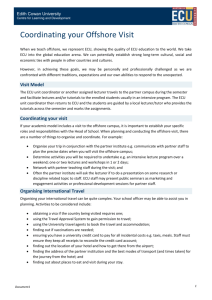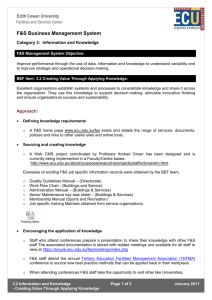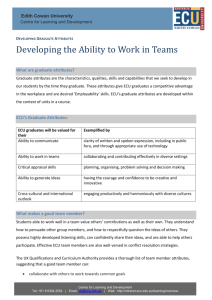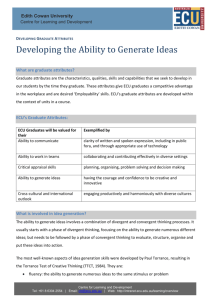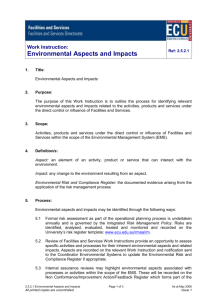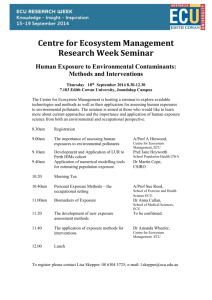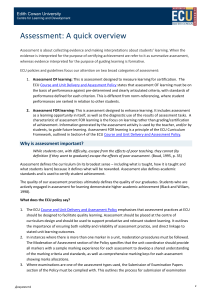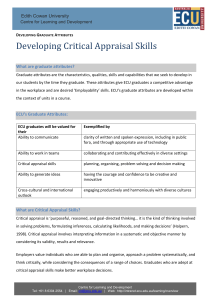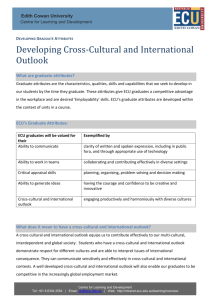Teaching Offshore: Localising curriculum
advertisement
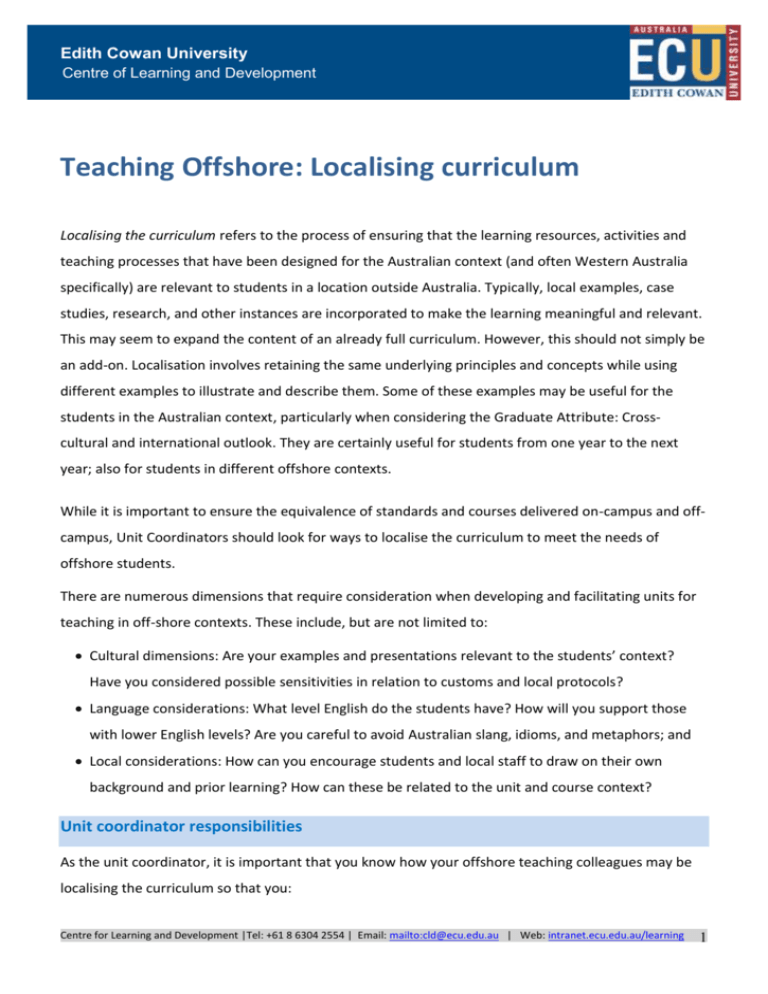
Edith Cowan University Centre of Learning and Development Teaching Offshore: Localising curriculum Localising the curriculum refers to the process of ensuring that the learning resources, activities and teaching processes that have been designed for the Australian context (and often Western Australia specifically) are relevant to students in a location outside Australia. Typically, local examples, case studies, research, and other instances are incorporated to make the learning meaningful and relevant. This may seem to expand the content of an already full curriculum. However, this should not simply be an add-on. Localisation involves retaining the same underlying principles and concepts while using different examples to illustrate and describe them. Some of these examples may be useful for the students in the Australian context, particularly when considering the Graduate Attribute: Crosscultural and international outlook. They are certainly useful for students from one year to the next year; also for students in different offshore contexts. While it is important to ensure the equivalence of standards and courses delivered on-campus and offcampus, Unit Coordinators should look for ways to localise the curriculum to meet the needs of offshore students. There are numerous dimensions that require consideration when developing and facilitating units for teaching in off-shore contexts. These include, but are not limited to: Cultural dimensions: Are your examples and presentations relevant to the students’ context? Have you considered possible sensitivities in relation to customs and local protocols? Language considerations: What level English do the students have? How will you support those with lower English levels? Are you careful to avoid Australian slang, idioms, and metaphors; and Local considerations: How can you encourage students and local staff to draw on their own background and prior learning? How can these be related to the unit and course context? Unit coordinator responsibilities As the unit coordinator, it is important that you know how your offshore teaching colleagues may be localising the curriculum so that you: Centre for Learning and Development |Tel: +61 8 6304 2554 | Email: mailto:cld@ecu.edu.au | Web: intranet.ecu.edu.au/learning 1 Edith Cowan University Centre of Learning and Development monitor the local content and teaching processes to ensure equivalence with onshore; keep a record then integrate their ideas and examples for other students; gather the local examples as resources and place some on the Blackboard; know how to localise the exam; and become acquainted with that local context and those students’ needs. It is important to ensure that the examination suits the local context. Often, local examples make better questions than those of a generic nature. Alternative examples within questions may be a useful way of integrating local contexts appealing to a wider range of students. You will need to guide your offshore lecturers and tutors in how you see the unit materials you have provided should be used. They should be encouraged to use local examples in lectures and workshops and send you these local examples. Some offshore teachers have previously expected that they must deliver your unit exactly how it is delivered and that they have no room to improvise or add their own thoughts and opinions. It may be useful to develop a facilitators’ guide. Supporting offshore tutors and lecturers The offshore lecturer must have a clear understanding of what you would like him/her to do. Some guidelines you may provide him/her might be: Adapt lecture slides and resources to use local example; Make explicit the main aspects of the week that must be understood by students Find ways to encourage students to be actively learning; Ask him/her to send you local examples for you to add to the Blackboard site; and Share his/her own comments and notes to students in a space you allocate in Blackboard. Ensure that students can approach him/her for clarification as necessary An example of localising curriculum content and teaching processes Writing the unit plan The unit plan is clearly laid out with a table of contents and clear headings. Bullet points are used to clarify crucial aspects of the unit and assessment. Centre for Learning and Development |Tel: +61 8 6304 2554 | Email: mailto:cld@ecu.edu.au | Web: intranet.ecu.edu.au/learning 2 Edith Cowan University Centre of Learning and Development Terms are used consistently within the unit plan and between the unit plan, the Blackboard site, and other resources. For example, if you call the Discussion board ‘Discussion board’, never refer to it as ‘Discussion forum’. Time is spent in class going over the vital items in the unit plan. The following activity samples have been adapted from the offshore unit, EPA5160 Leading Education in a Global Context. This unit is taught by an ECU academic from Perth through a short visit in China. Please notice how each task is broken down into parts and the keywords are in bold. Example 1 - Assignment All students have been provided with two readings that describe the current social climate of Australian education in regards to government policies. Chinese students are provided with the following assignment: Assignment 2 Review the five key ideas in the two readings provided. Comment on the relevance to the situation in China today. Your essay should include: Reasons for similarities and differences between China and Australia; Relevant examples from your own workplace; and What you would like to see happen in China to ensure it has a strong system of education that serves the best interests of the nation in a globalised world? Example 2 – Classroom activity The lecturer presents a case study of an Australian school to the class. Ask students to consider: What factors control how a school in China is governed? The lecturer lists the factors as identified by the students. Clarify any language items in English and Chinese that may have been brought out in this task. In groups, ask students to: Centre for Learning and Development |Tel: +61 8 6304 2554 | Email: mailto:cld@ecu.edu.au | Web: intranet.ecu.edu.au/learning 3 Edith Cowan University Centre of Learning and Development Identify which of these elements reflect internal controls and which reflect external controls? After discussing as a whole group, students work in groups to consider: How these factors influence the operation of a school with respect to: The availability of resources; Development of curriculum; Pedagogy; and Deployment of staff. Ideas are fed back to whole group. Follow up: Students are asked to respond to one of the factors identified on the discussion board, describing whether it is controlled internally or externally and considering how the factors influence the operation of the school. Example 3 – Discussion board activity Students are asked to consider a topic that is directly relevant to a Chinese context: In June 2010, the Chinese Government released a 10-year education reform blueprint for schools in China. Part 1: In 150 words, describe: a. What is one implication for schools in China? b. What strategies will need to be developed and supported to ensure the blueprint goals can be achieved for the implication you have named (a)? Part 2: Read other students’ posts. Respond to at least one other student’s post. What else could this student include? Thank you to Graeme Lock and Keith Newton for providing these examples. Centre for Learning and Development |Tel: +61 8 6304 2554 | Email: mailto:cld@ecu.edu.au | Web: intranet.ecu.edu.au/learning 4


